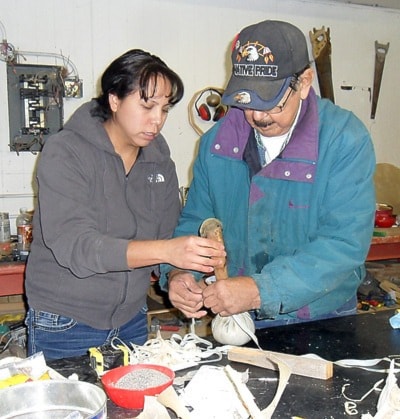By Arlene Mitchell
Headstart Coordinator
Simpcw First Nation
The Little Moccasins Head Start Program Simpcw First Nation hosted a Traditional Rattle making workshop on Nov. 19 and 20. Seventeen eager participants enjoyed the weekend of learning how to make rattles which was facilitated by Elder Sam Saul.
Sam took the participants through the whole process of rattle making from start to finish. Sam explained he uses the traditional method of soaking a hide, scrapping off the hair, then stretching and drying the hide. The hide is then ready to use for rattles, drums, etcetera.
Three different hides were used during the workshop, buffalo, deer and moose, and the participants were shown how to measure and cut the hide to fit the type of rattle they would be making.
For the deer antler rattles participants traced and cut the shape of the antler onto the hide. The hide is then soaked and scrapped again. When pliable the hide is prepared for the rattle by determining what shape you are making and the materials needed.
A leather punch is used to make holes, and rawhide straps cut for sewing the rattle together.
Whenshaping the rattle, sand is poured into the wet rawhide, the rawhide is then shaped, and then hung to dry. When dry the sand is poured out and rocks, beads, etcetera are placed inside the rattle. Next the handle is attached, which can be made from antlers, wood, bone, and so on.
It was noted that over the years some truly amazing rattles have been made using the same method that today’s participants learned during the weekend.
Nine different types of rattles were completed by the participants. It was a great experience and a fun filled weekend for everyone.
